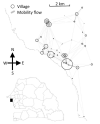Targeting Malaria Hotspots to Reduce Transmission Incidence in Senegal
- PMID: 33374228
- PMCID: PMC7796302
- DOI: 10.3390/ijerph18010076
Targeting Malaria Hotspots to Reduce Transmission Incidence in Senegal
Abstract
In central Senegal, malaria incidence declined in response to scaling-up of control measures from 2000 to 2010 and has since remained stable, making elimination unlikely in the short term. Additional control measures are needed to reduce transmission. We simulated chemoprophylaxis interventions targeting malaria hotspots using a metapopulation mathematical model, based on a differential-equation framework and incorporating human mobility. The model was fitted to weekly malaria incidence from 45 villages. Three approaches for selecting intervention targets were compared: (a) villages with malaria cases during the low transmission season of the previous year; (b) villages with highest incidence during the high transmission season of the previous year; (c) villages with highest connectivity with adjacent populations. Our results showed that intervention strategies targeting hotspots would be effective in reducing malaria incidence in both targeted and untargeted areas. Regardless of the intervention strategy used, pre-elimination (1-5 cases per 1000 per year) would not be reached without simultaneously increasing vector control by more than 10%. A cornerstone of malaria control and elimination is the effective targeting of strategic locations. Mathematical tools help to identify those locations and estimate the impact in silico.
Keywords: human mobility; intervention chemotherapy; malaria elimination; mathematical model.
Conflict of interest statement
The authors declare no conflict of interest.
Figures








References
-
- World Health Organization (WHO) World Malaria Report 2018. [(accessed on 30 October 2020)]; Available online: https://www.who.int/malaria/publications/world-malaria-report-2018/en/
-
- Wotodjo A.N., Richard V., Boyer S., Doucoure S., Diagne N., Touré-Baldé A., Tall A., Faye N., Gaudart J., Trape J.-F., et al. The implication of long-lasting insecticide-treated net use in the resurgence of malaria morbidity in a Senegal malaria endemic village in 2010–2011. Parasites Vectors. 2015;8:267. doi: 10.1186/s13071-015-0871-9. - DOI - PMC - PubMed
-
- Trape J.F., Tall A., Sokhna C., Ly A.B., Diagne N., Ndiath O., Mazenot C., Richard V., Badiane A., Dieye-Ba F., et al. The rise and fall of malaria in a West African rural community, Dielmo, Senegal, from 1990 to 2012: A 22 year longitudinal study. Lancet Infect. Dis. 2014;14:476–488. doi: 10.1016/S1473-3099(14)70712-1. - DOI - PubMed
-
- Programme National de Lutte contre le Paludisme (PNLP) Plan Stratégique National de Lutte Contre le Paludisme au Sénégal 2016–2020. [(accessed on 30 October 2020)]; Available online: http://www.pnlp.sn/wp-content/uploads/2016/08/PNLP_PSN_VFF_03-02-2016.pdf.
Publication types
MeSH terms
LinkOut - more resources
Full Text Sources
Medical

